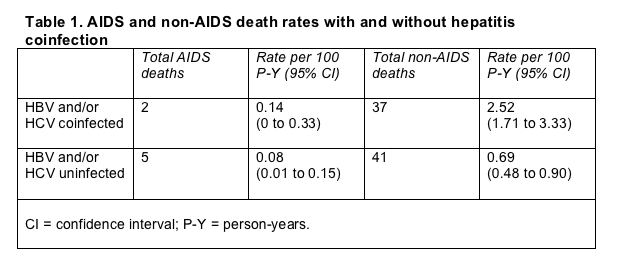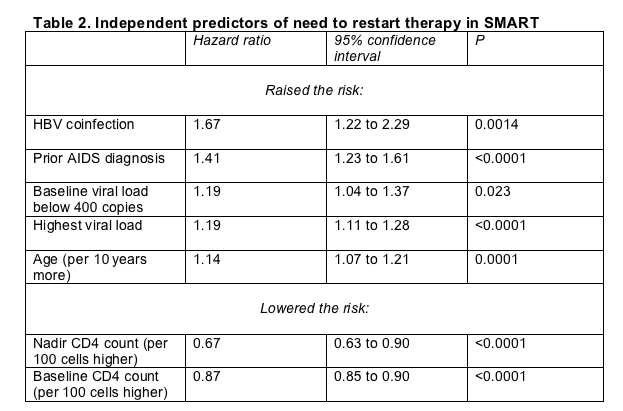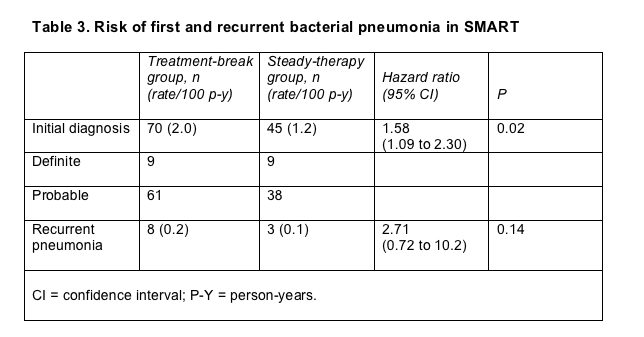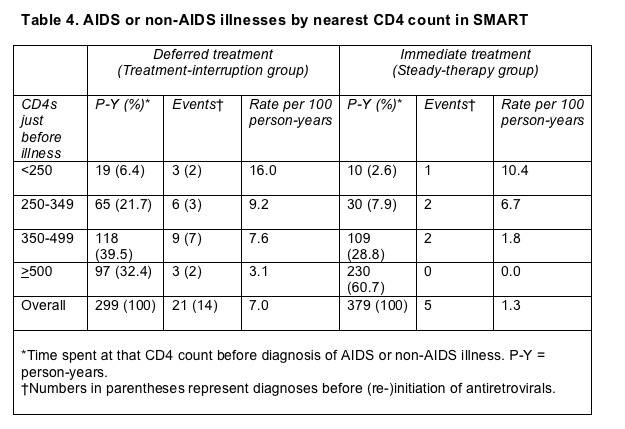 |
 |
 |
| |
SMART Yields More Reasons To Shun Drug Breaks
|
| |
| |
4th IAS Conference on HIV Pathogenesis, Treatment, and Prevention
July 22-25, 2007
Sydney, Australia
Mark Mascolini
Immediately below are links to the full reports of some the underlying studies including slides and graphs discussed in the report following below.
HCV/HBV Coinfected at Greater Risk in SMART - (08/01/06)
Higher rate of HAART reinitiation among HIV-HBV coinfected patients in the episodic arm of the SMART study - (08/01/06)
Effects of alternate treatment protocols (discontinuation vs viral suppression) on the incidence of electrocardiographic abnormalities among HIV-infected adults in the SMART trial - (08/06/07)
SMART, the trial comparing continuous antiretroviral therapy with CD4-count-guided drug breaks, started with the hypothesis that drug holidays would lower the risk of antiretroviral side effects without threatening progression of HIV infection [1]. But it ended with a trove of data showing that treatment lulls pose a substantial risk of HIV progression while making a host of non-AIDS complications more likely.
At the February 2007 Conference on Retroviruses and Opportunistic Infections, SMART statistician Andrew Phillips reported that CD4-guided treatment breaks heightened chances of heart disease, possibly because steady antiretroviral therapy exerts an overall positive effects on risk factors [2].
At the 4th IAS Conference on HIV Pathogenesis, Treatment, and Prevention, SMART investigators served up results of fresh analyses showing that:
- Interrupting antiretrovirals proved "particularly unsafe" for people with hepatitis B or C virus (HBV or HCV) infection [3].
- SMART enrollees coinfected with HBV had to restart antiretrovirals more often than those without HBV [4].
- People who took drug holidays in SMART ran a greater risk of bacterial pneumonia than steadily treated study participants [5].
- Suspending therapy may lead to myocardial damage, increasing repolarization abnormalities, and increased heart rate [6].
- Previously untreated people who waited longer to start antiretrovirals because they got randomized to the treatment-break group ran a significantly higher risk of opportunistic disease and non-AIDS illness than the immediately treated group [7].
SMART signed up 5472 mostly treatment-experienced people and assigned 2752 to keep taking antiretrovirals regardless of CD4 count and 2720 to defer treatment until their CD4s tumbled below 250, then to resume or start therapy, only to stop again when CD4s climbed back above 350 [1]. The trial came to an abrupt end in January 2006, after an average 16 months of follow-up, when investigators found a 2.6 times higher risk of opportunistic disease or death as well as higher risks of heart, liver, and kidney disease in the drug-holiday group.
Drug holidays and hepatitis don't mix
Two SMART substudies showed that CD4-guided treatment breaks may be a particularly bad idea for people coinfected with HBV or HCV [3,4]. Analysis of 922 SMART enrollees coinfected with HBV and/or HCV found that they accounted for about half of all non-AIDS deaths during the study, even though coinfected people made up only 17% of the whole cohort [3].
Defining chronic HBV as a positive test for hepatitis B surface antigen for more than 6 months and chronic HCV as positive for HCV antibody, the SMART team counted 922 coinfected people in the whole cohort (16.8%) and analyzed 467 in the drug-break group and 446 in the steady-therapy group. Equivalent proportions in both study arms had HBV only (n = 110), HCV only (n = 798), or both HBV and HCV (n = 14). In the coinfected subgroups, nadir (lowest-ever) CD4 count and CD4s at study entry were also equivalent in the two groups (median nadir 257 in the treatment-interruption group and 250 in the steady-therapy group; median entry CD4s 598 in the interruption group and 567 in the steady group). About two thirds of coinfected SMART enrollees had a viral load under 400 copies and about one quarter had AIDS.
When SMART ended, risk of opportunistic disease or death proved nearly identical in treatment interrupters with and without HBV or HCV coinfection. Coinfected people who took drug holidays had a 2.58 times higher risk of opportunistic disease or death than people who stayed on therapy. Among SMART enrollees without HBV or HCV, that risk was 2.57 times higher in the drug-holiday group.
Risk of death from a nonopportunistic disease proved 3.9 times higher in coinfected break takers than in the HIV-only drug-break group, and 3.5 times higher in the coinfected steady-therapy group than in the HIV-only steady-treatment group. SMART statisticians figured that this higher risk of non-AIDS deaths in coinfected people entirely accounted for the overall 2-fold higher risk of opportunistic disease or death in coinfected versus noncoinfected enrollees. The overall risk of a non-AIDS death was more than 3.5 times higher in coinfected people than in people without hepatitis virus coinfection (Table 1).

But hepatitis itself did not explain the higher non-AIDS death risk in HBV/HCV-coinfected people. In the coinfected group death rates per 100 person-years measured about 0.2 for liver disease, 0.3 for kidney disease, and 0.5 for non-AIDS cancers and substance abuse.
SMART investigators concluded that because the risk of non-AIDS deaths runs so much higher in HBV/HCV-coinfected people, "the strategy of antiretroviral therapy interruption is particularly unsafe in these patients."
Using the same definitions of chronic HBV and HCV infection, another SMART team discovered that HBV coinfection by itself made restarting antiretrovirals more likely in treatment interrupters [4]. This analysis focused on 2669 study participants, all of them randomized to take CD4-guided drug breaks. Median baseline CD4 count measured 560 in 65 people coinfected with HBV, 608 in 402 people with HCV, and 595 in 2202 infected only with HIV. Respective nadir CD4 counts stood at 207, 265, and 250. Similar proportions in all three groups were taking tenofovir, emtricitabine (FTC), and/or 3TC.
In the average 16 months of follow-up, 63.1% of study participants in the HBV group had to resume therapy, compared with 45.5% in the HCV group and 39.2% in the group without HBV or HCV. Median CD4 counts when treatment resumed were similar in the three groups--233 with HBV, 240 with HCV, and 232 with neither hepatitis virus. A multifactor analysis pinpointed seven factors that independently made treatment resumption more or less likely, including HBV coinfection, which raised the risk by two thirds (Table 2). HCV coinfection had no impact on the need to restart therapy.

Lowered the risk:
Nadir CD4 count (per 100 cells higher) 0.67 0.63 to 0.90 <0.0001
Baseline CD4 count (per 100 cells higher) 0.87 0.85 to 0.90 <0.0001
Hepatic flares or restarting antiretrovirals at higher CD4 counts did not explain the higher resumption rate in people with HBV. Rather, SMART statisticians reckoned that HBV-coinfected people had to resume treatment more because their CD4 counts plunged faster than those of other people when they took drug breaks. While 24.4% in the HBV group who resumed treatment did so because of a speedy CD4 drop, 21.6% without hepatitis and 16.4% with HCV restarted therapy for that reason.
High pneumonia risk and skittish ECGs with drug breaks
Off-and-on treatment in SMART raised the risk of both bacterial pneumonia [5] and electrocardiographic (ECG) abnormalities that signal myocardial damage [6]. The first study also isolated smoking as an independent predictor of pneumonia.
SMART researchers considered bacterial pneumonia confirmed if a study participant met criterion A or B in the following list or C plus D plus E:
A. Histologic evidence of bacterial pneumonia by autopsy or biopsy
B. Positive quantitative culture of a protected brush specimen for likely pathogen
C. Signs and symptoms suggesting bacterial pneumonia
D. Chest x-ray compatible with bacterial pneumonia
E. Bacterial pathogen identified in blood culture or bronchoscopic sputum culture, or Legionella or pneumococcal antigen in urine or blood, or diagnostic serologic findings
SMART tabulators considered bacterial pneumonia probable in people who met both criteria C and D above.
Study participants randomized to treatment interruptions or steady therapy had similar median baseline CD4 counts (597 and 598), and both groups had a median nadir of 250 cells. Nearly three quarters in each group began SMART with a viral load under 400 copies. High proportions in both SMART arms smoked at the time of the study (41.3% among interrupters, 39.7% in the control arm) or smoked in the past (24.6% and 25.0%).
Bacterial pneumonia turned out to be the most common clinical diagnosis in SMART, affecting 115 study participants, though no one died as a result. After an average 16 months of follow-up, people in the drug-break group had a significantly higher bacterial pneumonia diagnosis rate and a trend toward a higher rate of recurrent pneumonia (Table 3).

Multivariate analysis determined that treatment breaks, current smoking, and prior recurrent bacterial pneumonia independently raised the risk of bacterial pneumonia during SMART at the following hazard ratios (HR) and 95% CIs. SMART statisticians also found strong trends toward a higher pneumonia risk in blacks and former smokers.
- Treatment interruption: HR 1.60, 95% CI 1.10 to 2.33, P = 0.01
- Current cigarette smoking: HR 1.82, 95% CI 1.09 to 3.04, P = 0.03
- Past cigarette smoking: HR 1.59, 95% CI 0.91 to 2.78, P = 0.10
- Blacks compared with whites: HR 1.46, 95% CI 0.98 to 2.25, P = 0.07
- Prior recurrent bacterial pneumonia: HR 2.61, 95% CI 1.34 to 5.12, P < 0.01
A separate analysis found that the higher pneumonia risk in the drug-holiday group dropped from 1.58 (P = 0.015) to 1.12 (P = 0.60) after statistical adjustment for latest CD4 count and viral load. That means lower CD4 counts and higher viral loads in the treatment-break group almost entirely explained their steeper pneumonia risk. For all SMART enrollees, the risk of bacterial pneumonia waned 8% with every additional 100 CD4 cells. But even people in the highest CD4 bracket when they came down with pneumonia--more than 500 cells--had more than a doubled risk of pneumonia if they were in the drug-break group (relative risk 2.12, P < 0.01).
SMART researchers believe their findings support the contention that "smoking cessation programs should be a part of routine HIV care." They stressed that "sustained use of antiretroviral drugs needs to be emphasized with patients as an important means to reduce the occurrence of one of the most commonly reported clinical events in HIV-infected patients--bacterial pneumonia."
Besides contributing frequent serum samples, 1123 SMART enrollees who interrupted treatment and 1078 who did not had a 12-lead ECG before the trial began and at least one ECG during follow-up [6]. People who suspended therapy had a 1.48 times higher risk of irregular Q waves, a sign of myocardial damage (95% CI 1.06 to 2.07). A wider QRS/T spatial angle on the ECGs of break takers augured a higher risk of cardiovascular death. And people who interrupted therapy had a higher resting heart rate. These talismans all reflect the higher heart disease rate verified in the treatment-interruption arm [2].
Starting later ups risk of AIDS and non-AIDS diagnoses
When SMART began, 447 participants had never swallowed an antiretroviral or were off treatment, including 249 people assigned to the drug-holiday group and 228 in the always-on-therapy group [7]. So people randomized to treatment breaks never began therapy until their CD4 count edged below 250, while those randomized to the control arm began treatment immediately. Whereas 249 people entered SMART with zero treatment experience, 228 had tried antiretrovirals but were taking no drugs at the time.
The immediately treated group began antiretrovirals with a median CD4 count of 435, compared with 243 in the deferred-treatment group. While the immediate group spent 89.5% of follow-up time taking antiretrovirals, the deferred group spent only 17.6% of their time on therapy.
After almost 3 years of follow-up, the deferred-treatment (drug-break) group ran more than a 4 times higher risk of (1) opportunistic disease or death or (2) a fatal or nonfatal opportunistic disease. People who put off treatment until their CD4s drifted below 250 had (3) a 7 times higher risk of a serious non-AIDS illness and (4) a 5 times higher risk of either a fatal or nonfatal opportunistic disease or a serious non-AIDS illness (a composite endpoint) at the following hazard ratios (HR) and 95% confidence intervals (CI):
1. Opportunistic disease or death: HR 4.38, 95% CI 1.45 to 13.2, P = 0.009
2. Fatal or nonfatal opportunistic disease: HR 4.40, 95% CI 1.23 to 15.8, P = 0.02
3. Serious non-AIDS illness: HR 7.05, 95% CI 1.58 to 31.5, P = 0.01
4. Endpoints 2 and 3 combined: HR 5.08, 95% CI = 1.91 to 13.5, P = 0.001
People with progressively lower CD4 counts just before diagnosis of an AIDS or a non-AIDS disease (the composite endpoint 4 above) had a progressively higher risk of such a diagnosis (Table 4). And that heightened risk always proved greater in the drug-break group than in the steady-therapy group.
Study participants who deferred treatment ended up spending about twice as much time with a CD4 count below 250 than people who started therapy right away (19 versus 10 patient-years) and about twice as much time with a count between 250 and 349 (65 versus 30 patient-years) (Table 4). In contrast, the immediately treated group spent more than twice as much follow-up time with a CD4 count above 500.

SMART investigators reckoned that immediate treatment cut the risk of opportunistic disease or a serious non-AIDS diagnosis by 5.7% compared with deferred therapy. They believe their results suggest that the higher risk of AIDS and non-AIDS setbacks in the deferred treatment group "appears to be determined, at least in part, by time spent with lower CD4 cell counts."
Mark Mascolini writes about HIV infection (markmascolini@earthlink.net).
References
1. The Strategies for Management of Antiretroviral Therapy (SMART) Study Group. CD4+ count–guided interruption of antiretroviral treatment. N Engl J Med. 2006;355:2283-2296.
2. Phillips A, Carr A, Neuhaus J, et al. Interruption of ART and risk of cardiovascular
disease: findings from SMART. 14th Conference on Retroviruses and Opportunistic Infections. February 25-28, 2007. Los Angeles. Abstract 41.
3. Tedaldi E, Puoti M, Neuhaus J, et al. Opportunistic disease and mortality in patients co-infected with hepatitis C virus (HCV) and/or hepatitis B virus (HBV) in the SMART (Strategic Management of Antiretroviral Therapy) study. 4th IAS Conference on HIV Pathogenesis, Treatment, and Prevention. July 22-25, 2007. Sydney. Abstract TUAB203
4. Dore G, Soriano V, Neuhaus J, et al. Higher rate of antiretroviral therapy reinitiation among HIV-HBV coinfected patients in the episodic therapy arm of the SMART study. 4th IAS Conference on HIV Pathogenesis, Treatment, and Prevention. July 22-25, 2007. Sydney. Abstract TUAB204.
5. Gordin F, Roediger M, Clezy K, et al. An increased risk of bacterial pneumonia in patients interrupting antiretroviral treatment: results from the SMART study. 4th IAS Conference on HIV Pathogenesis, Treatment, and Prevention. July 22-25, 2007. Sydney. Abstract MOPEB100.
6. Prineas R, Roediger M, Carr A, et al. Effect of alternate treatment protocols on the incidence of electrocardiographic abnormalities among HIV infected adults in the SMART trial. 4th IAS Conference on HIV Pathogenesis, Treatment, and Prevention. July 22-25, 2007. Sydney. Abstract WEPEB077.
7. Emery S, SMART Study Group and INSIGHT. Major clinical outcomes in patients not treated with antiretroviral therapy (ART) at baseline in SMART: a rationale for a trial to examine early treatment of HIV disease. 4th IAS Conference on HIV Pathogenesis, Treatment, and Prevention. July 22-25, 2007. Sydney. Abstract WEPEB018.
|
| |
|
 |
 |
|
|